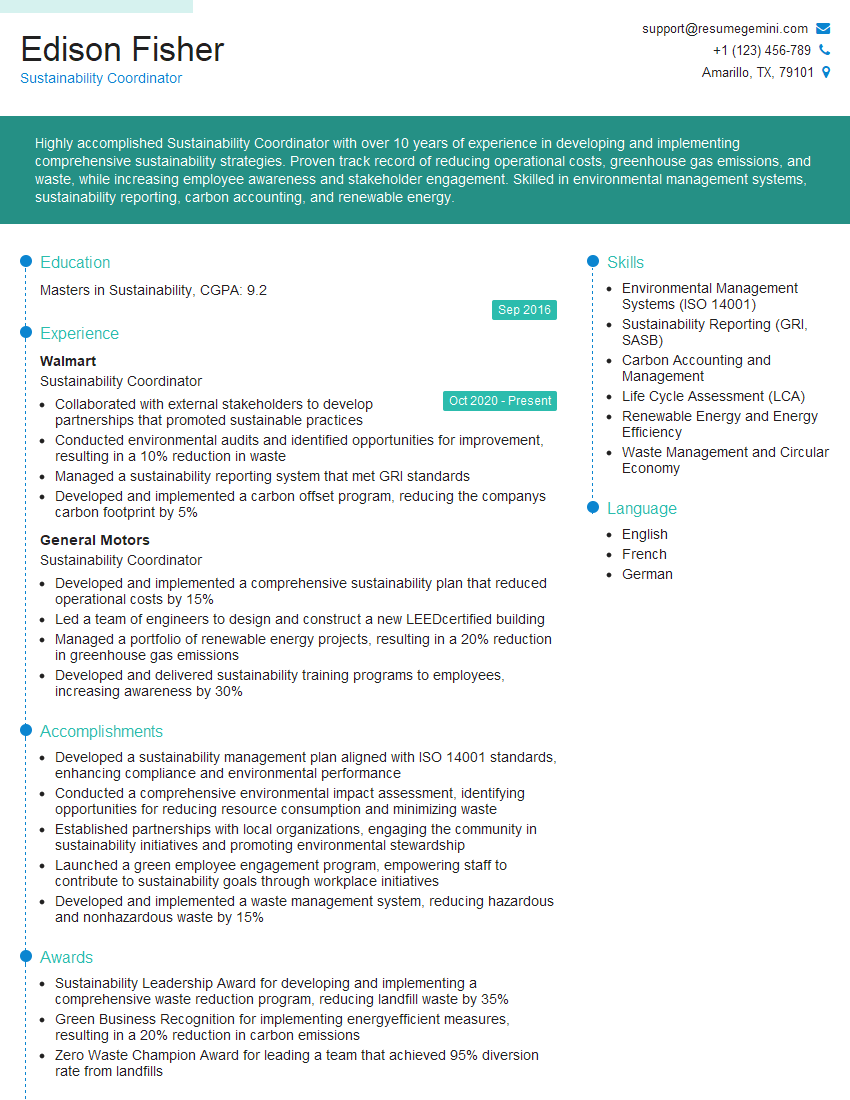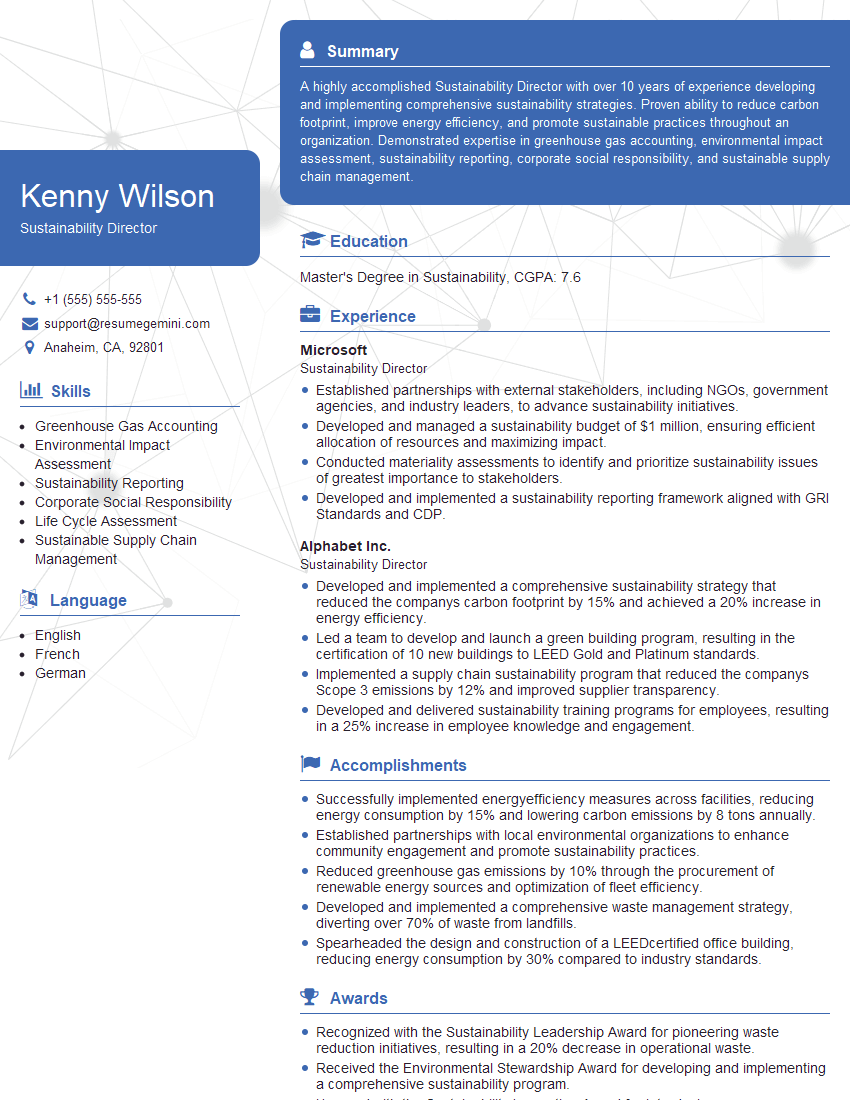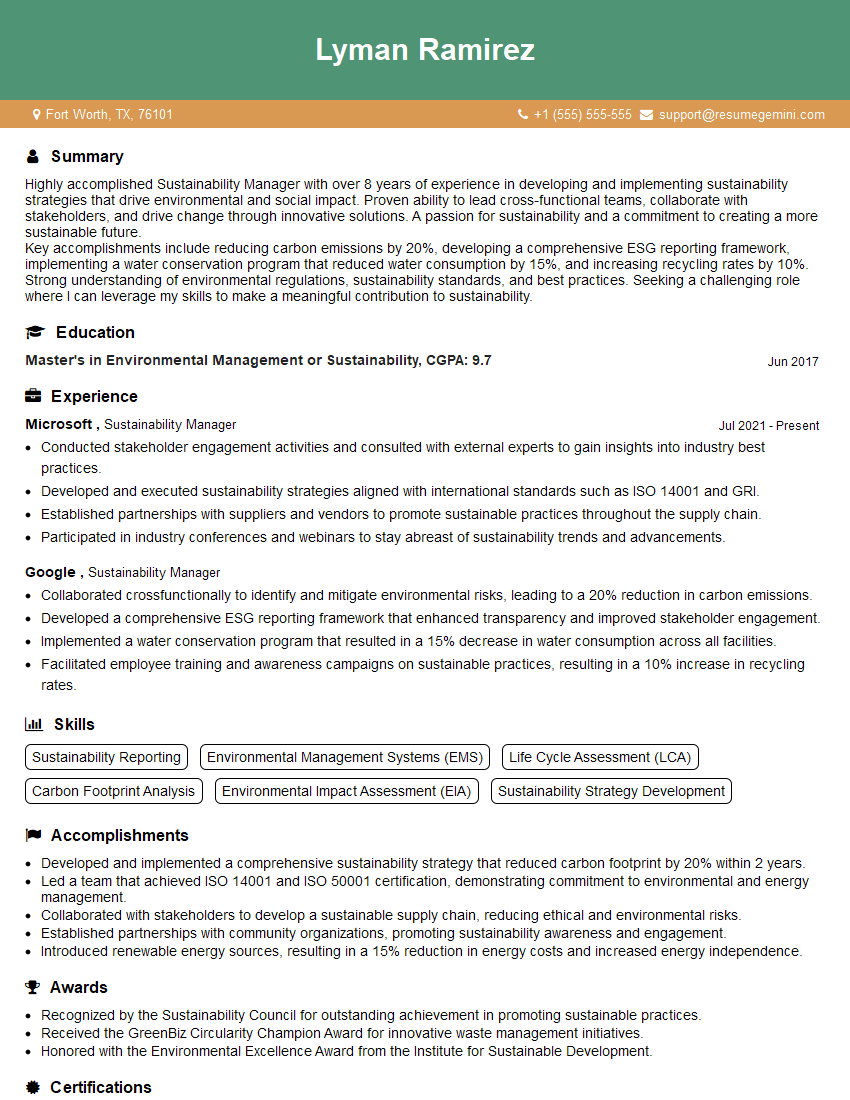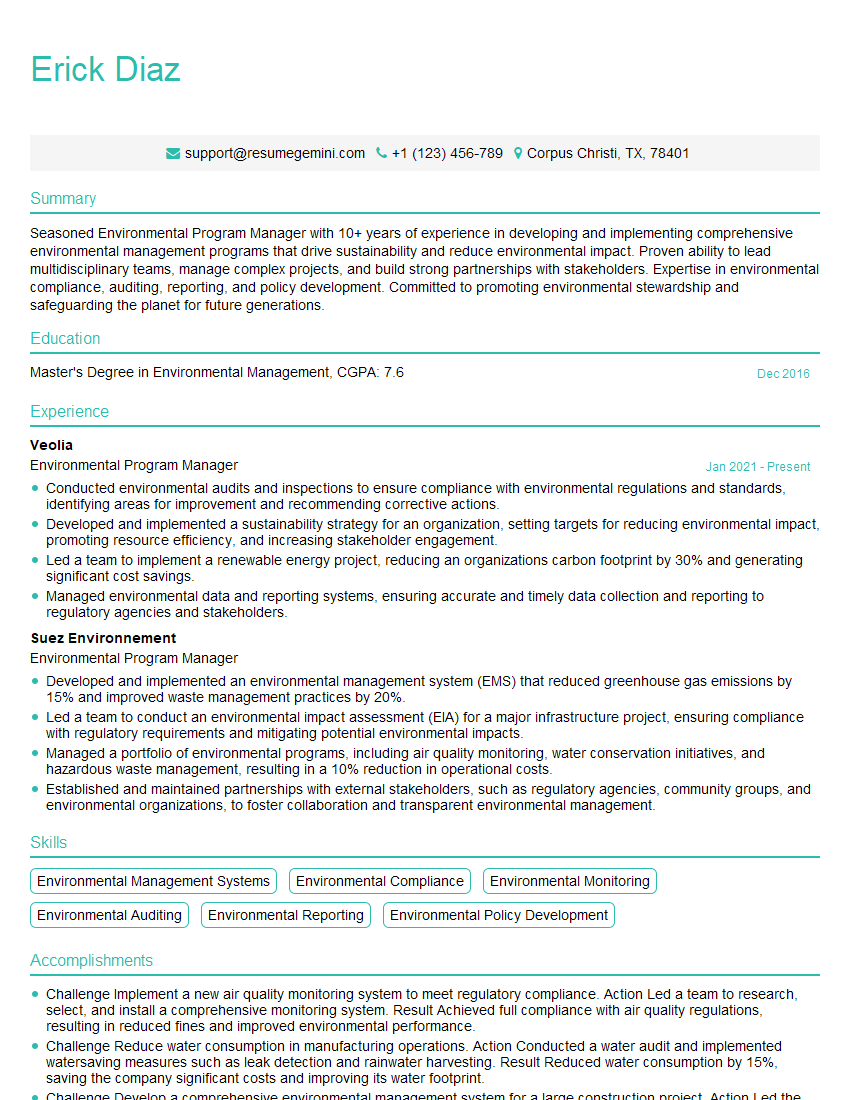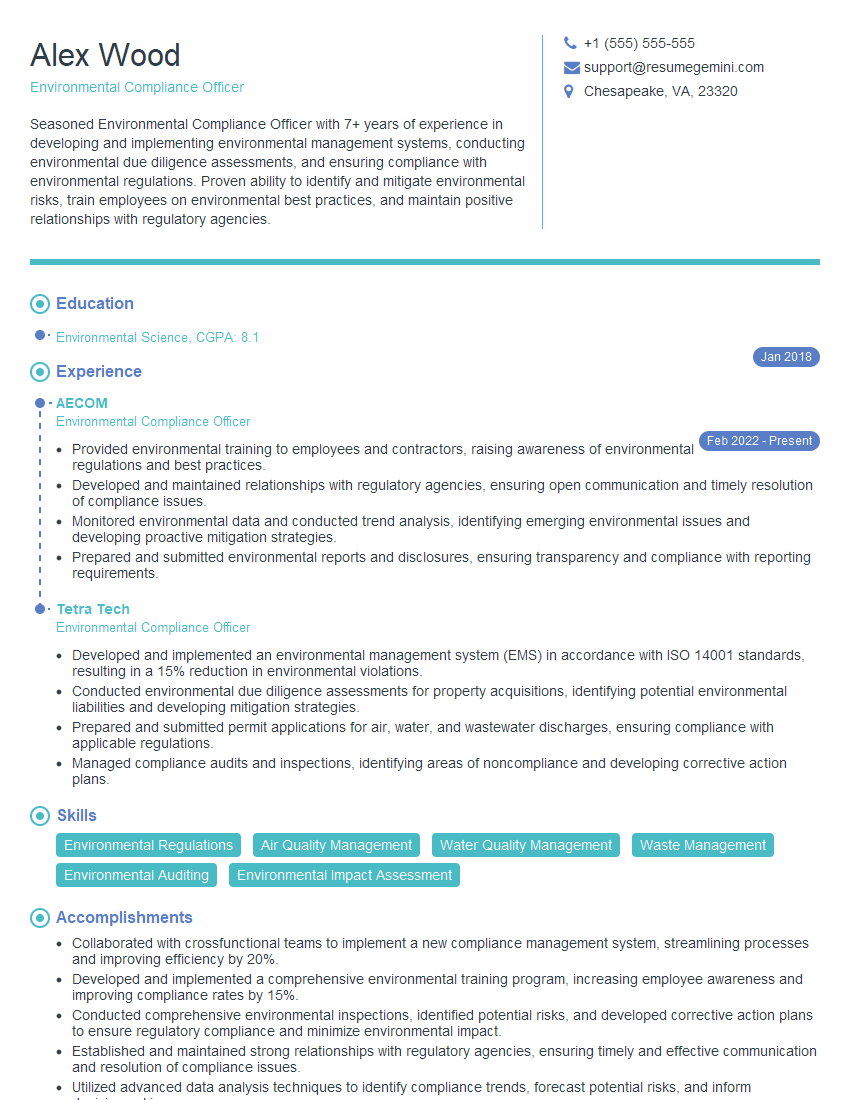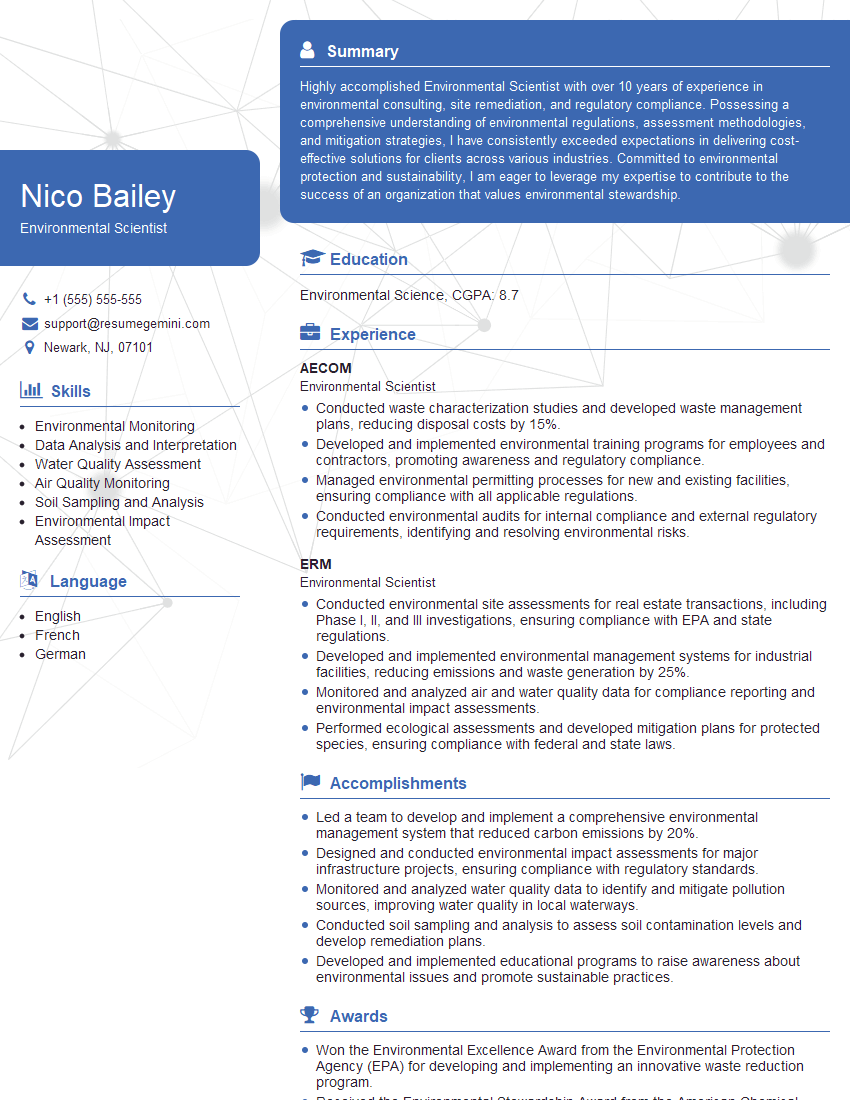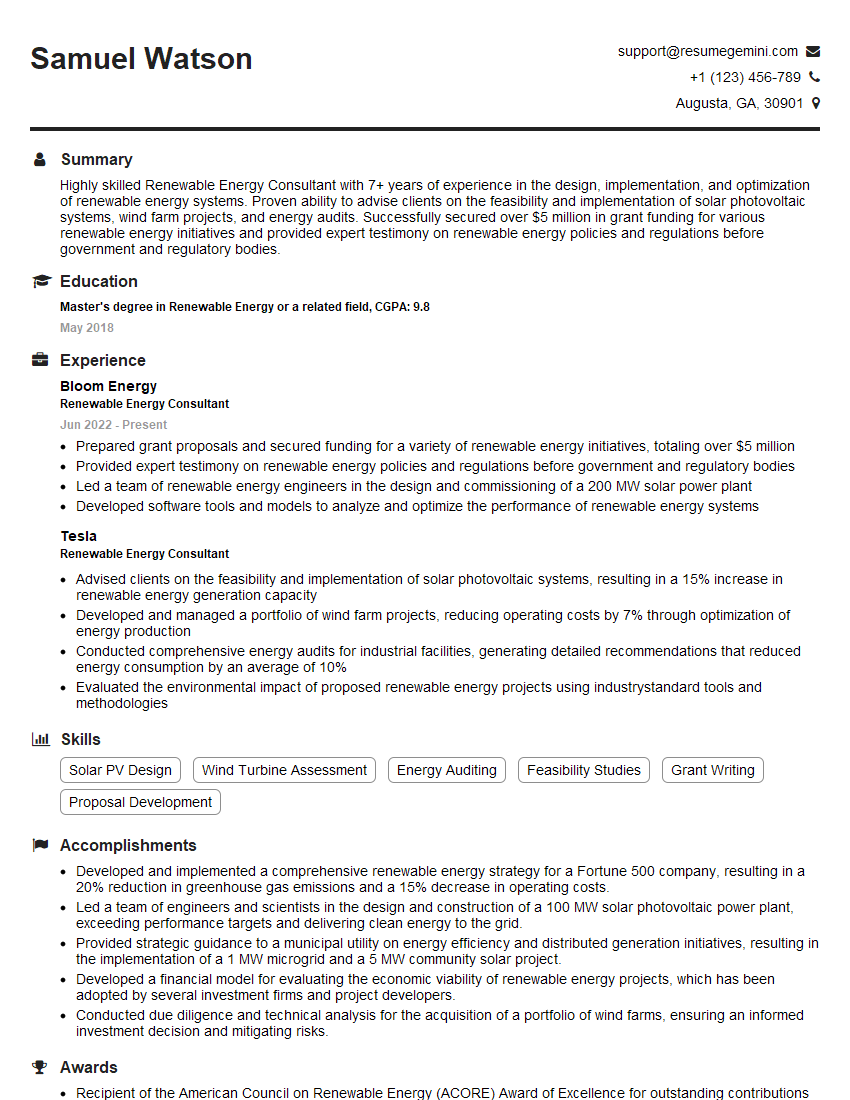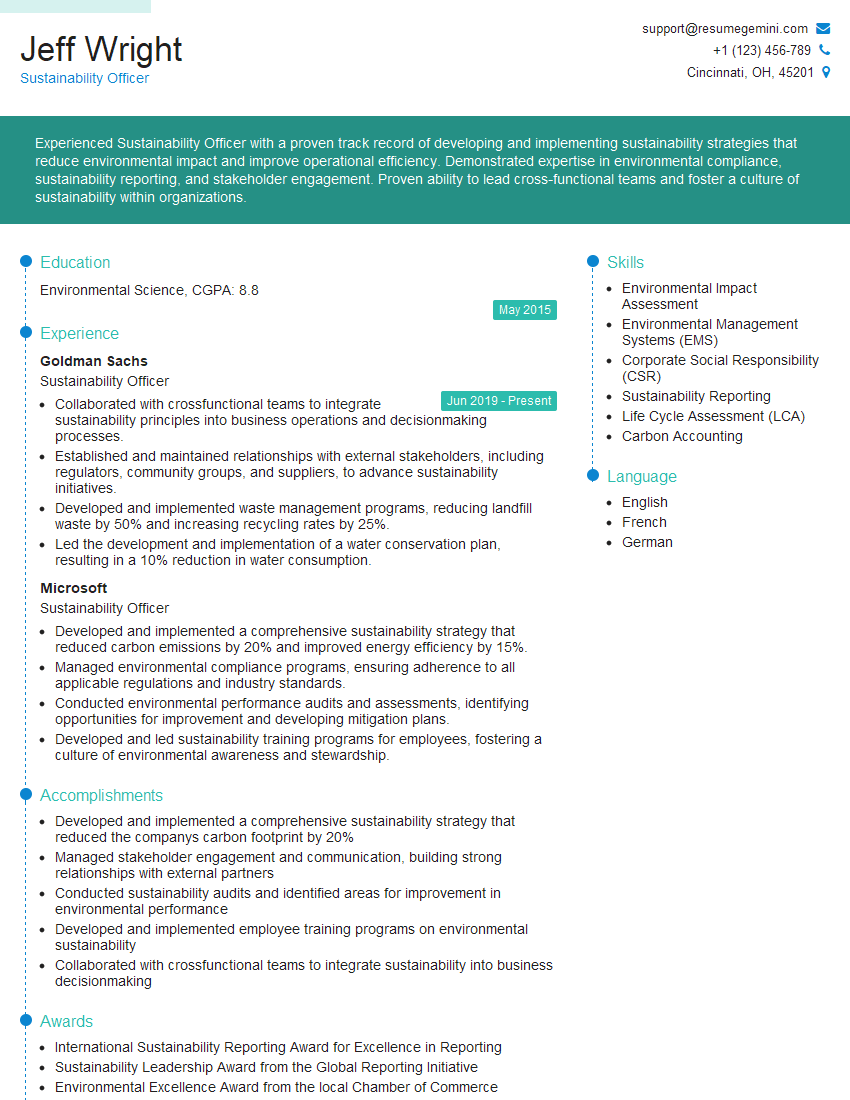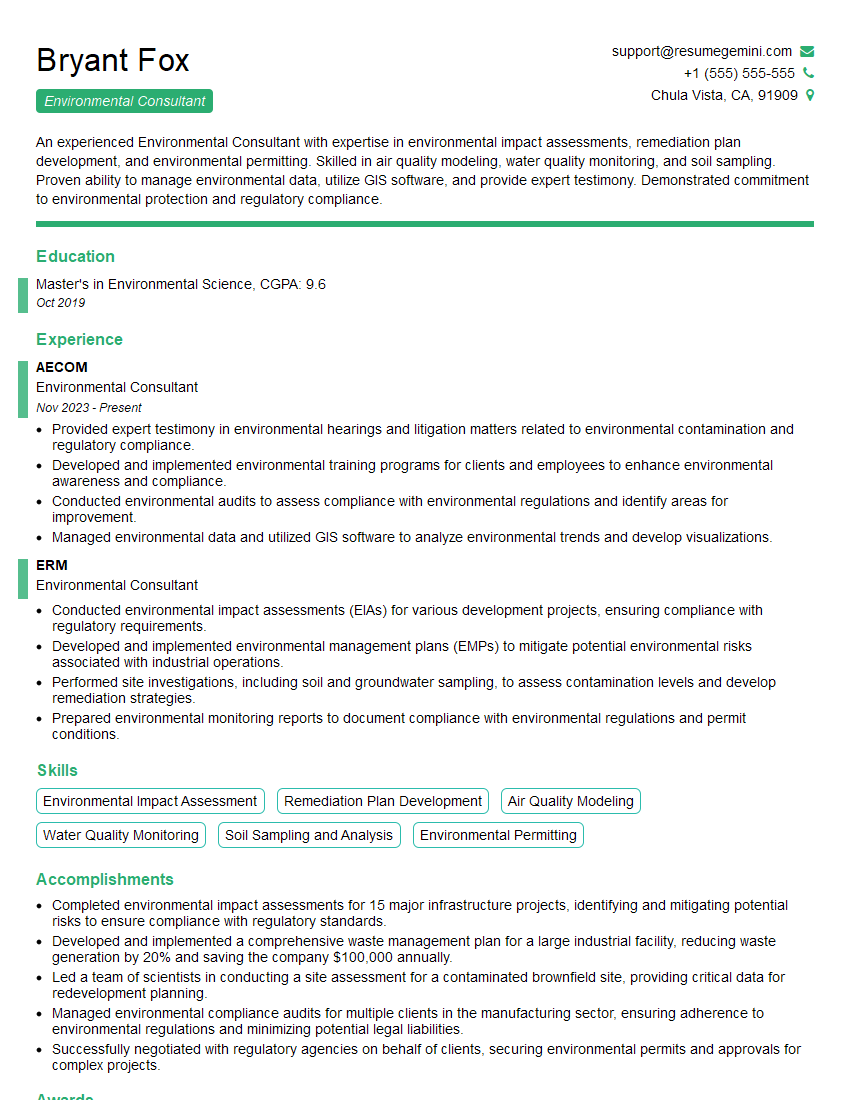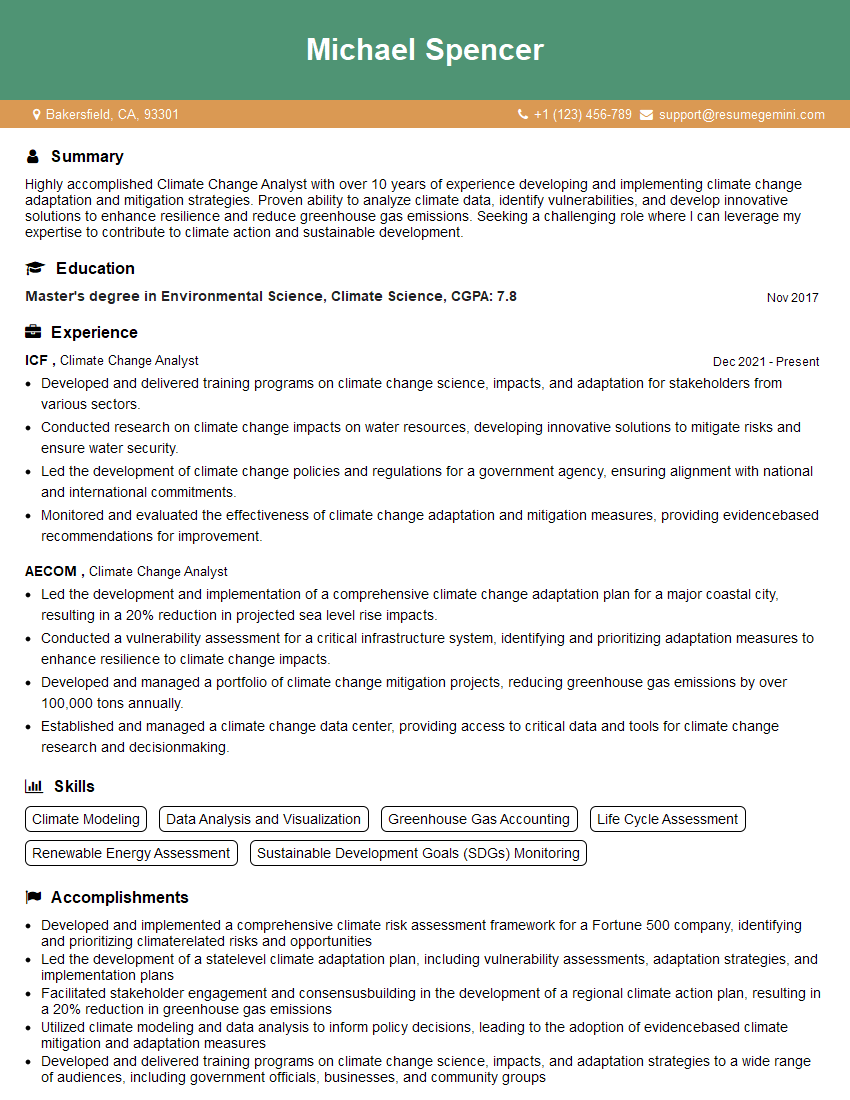Every successful interview starts with knowing what to expect. In this blog, we’ll take you through the top Climate Action Planning interview questions, breaking them down with expert tips to help you deliver impactful answers. Step into your next interview fully prepared and ready to succeed.
Questions Asked in Climate Action Planning Interview
Q 1. Describe your understanding of the Paris Agreement and its implications for climate action planning.
The Paris Agreement is a landmark international accord adopted in 2015, aiming to limit global warming to well below 2°C, preferably to 1.5°C, compared to pre-industrial levels. It’s a legally binding treaty committing nearly every nation to reduce greenhouse gas emissions and adapt to the impacts of climate change. For climate action planning, this implies a global shift towards low-carbon economies. National governments must develop and implement Nationally Determined Contributions (NDCs), which are detailed plans outlining their emission reduction targets and strategies. These NDCs are crucial for driving climate action planning at national and sub-national levels. The Paris Agreement’s implications include the need for robust monitoring, reporting, and verification systems to track progress and ensure accountability. It also emphasizes the importance of international collaboration, technology transfer, and financial support for developing countries in their climate action efforts. Essentially, it provides the framework within which all climate action planning should be undertaken, requiring integration of mitigation and adaptation goals at all levels.
Q 2. Explain the difference between climate change mitigation and adaptation strategies.
Climate change mitigation and adaptation are two distinct but complementary strategies to address climate change. Mitigation focuses on reducing the causes of climate change. This involves reducing greenhouse gas emissions through transitioning to renewable energy sources (like solar and wind), improving energy efficiency, adopting sustainable transportation systems, and implementing sustainable land use practices. Think of mitigation as preventing the problem from getting worse. Adaptation, on the other hand, focuses on managing the consequences of climate change. This involves adjusting to the effects of climate change that are already happening or are expected to happen in the future, such as sea-level rise, extreme weather events, and changes in agricultural yields. Examples of adaptation measures include building seawalls, developing drought-resistant crops, improving water management systems, and implementing early warning systems for extreme weather. Imagine adaptation as coping with the existing and inevitable consequences of the problem.
Q 3. What are the key greenhouse gases, and how do they contribute to climate change?
The key greenhouse gases (GHGs) driving climate change include carbon dioxide (CO2), methane (CH4), nitrous oxide (N2O), and fluorinated gases (like hydrofluorocarbons or HFCs). CO2 is the most significant contributor, primarily released from the burning of fossil fuels (coal, oil, and natural gas) for energy production, transportation, and industrial processes. Methane is a more potent GHG than CO2, though it has a shorter lifespan in the atmosphere. Significant sources of methane include agriculture (livestock and rice cultivation), landfills, and natural gas leaks. Nitrous oxide comes mainly from agricultural practices, industrial processes, and the burning of fossil fuels. Fluorinated gases are synthetic GHGs used in various industrial applications; they are significantly more potent than CO2 but are present in smaller quantities. These gases trap heat in the Earth’s atmosphere, leading to the greenhouse effect and global warming. The increased concentration of these gases due to human activities is the primary driver of observed climate change.
Q 4. How would you assess the carbon footprint of an organization?
Assessing an organization’s carbon footprint involves quantifying its direct and indirect greenhouse gas emissions. This requires a systematic approach:
- Identify emission sources: This includes direct emissions (Scope 1) like fuel combustion on-site and fugitive emissions, indirect emissions from purchased electricity (Scope 2), and other indirect emissions from the value chain (Scope 3) such as supply chain emissions, transportation, and waste disposal.
- Data collection: Gather data on energy consumption (electricity, heating, fuel), waste generation, travel, and supply chain activities. This may involve reviewing utility bills, purchase orders, and engaging with suppliers.
- Emission calculation: Use emission factors (available from sources like the EPA or IPCC) to convert activity data into greenhouse gas emissions, usually expressed in tons of CO2 equivalent (tCO2e).
- Verification and reporting: Review the calculations for accuracy and ensure consistency with relevant standards (e.g., GHG Protocol). Report the findings transparently, highlighting areas for improvement.
Q 5. What are some common methodologies used for life cycle assessment (LCA)?
Life cycle assessment (LCA) is a standardized methodology for evaluating the environmental impacts of a product or service throughout its entire life cycle, from raw material extraction to end-of-life disposal. Several methodologies exist, including:
- ISO 14040/14044: This is the most widely used international standard for LCA, providing a framework for conducting LCAs in a consistent and transparent manner.
- ReCiPe (ReCiPe Endpoint): This is a widely used impact assessment methodology that categorizes environmental impacts into various endpoint categories (e.g., human health, ecosystem quality, resources).
- Eco-indicator 99: Another widely used impact assessment methodology that translates environmental impacts into a single score, allowing for comparisons between different products or services.
Q 6. Describe your experience with developing and implementing sustainability strategies.
In my previous role at [Previous Company Name], I led the development and implementation of a comprehensive sustainability strategy. This involved:
- Stakeholder engagement: We conducted workshops and surveys to understand stakeholder expectations and priorities.
- Materiality assessment: We identified the most significant environmental and social impacts of our operations.
- Target setting: We established ambitious targets for reducing greenhouse gas emissions, waste, and water consumption.
- Implementation plan: We developed a detailed plan outlining specific actions, timelines, and responsibilities.
- Monitoring and reporting: We established a robust monitoring system to track progress and reported our performance publicly.
Q 7. How would you prioritize climate action initiatives within a limited budget?
Prioritizing climate action initiatives with a limited budget requires a strategic approach. I’d employ a multi-criteria decision analysis (MCDA) framework, considering factors such as:
- Cost-effectiveness: Identify initiatives with high emission reduction potential at a relatively low cost.
- Impact: Focus on initiatives with the greatest potential to reduce greenhouse gas emissions.
- Feasibility: Assess the technical and logistical feasibility of each initiative.
- Alignment with strategic goals: Prioritize initiatives that align with the organization’s broader strategic goals.
- Stakeholder support: Consider stakeholder buy-in and support for each initiative.
Q 8. What are some key performance indicators (KPIs) you would use to measure the success of a climate action plan?
Measuring the success of a climate action plan requires a robust set of Key Performance Indicators (KPIs). These KPIs should track progress across various sectors and reflect both mitigation (reducing greenhouse gas emissions) and adaptation (adjusting to climate change impacts) efforts. A balanced approach is crucial.
Greenhouse Gas Emission Reductions: This is fundamental. KPIs could include the total emissions reduced (in tons of CO2e), the percentage reduction compared to a baseline year, or emissions per capita. For example, tracking the reduction in emissions from the transportation sector through the adoption of electric vehicles and improved public transport would be vital.
Renewable Energy Deployment: KPIs here could include the percentage of electricity from renewable sources (solar, wind, hydro), the total installed renewable energy capacity (in megawatts), and the growth rate of renewable energy deployment. For example, we could track the number of new solar panels installed annually.
Energy Efficiency Improvements: KPIs can measure energy consumption per unit of GDP, energy intensity reductions in specific sectors (e.g., buildings, industry), and the number of energy efficiency upgrades implemented. An example might be tracking the energy consumption per square foot in commercial buildings.
Climate Resilience Indicators: These are crucial for adaptation. Examples include the number of climate-resilient infrastructure projects completed, the area protected from flooding or other climate hazards, and improved community preparedness for extreme weather events. For instance, we could measure the number of communities that have implemented early warning systems for heat waves.
Carbon Sequestration: Tracking the amount of carbon absorbed by natural sinks (forests, wetlands) or through carbon capture and storage technologies is vital. This might be measured in tons of CO2 sequestered annually.
Regular monitoring and reporting against these KPIs are essential for demonstrating progress, identifying challenges, and making necessary adjustments to the plan.
Q 9. How familiar are you with different renewable energy technologies?
I am very familiar with various renewable energy technologies. My expertise spans across different generations and types, encompassing their technological principles, environmental impacts, economic viability, and integration challenges within existing energy systems.
Solar Photovoltaics (PV): Direct conversion of sunlight into electricity. I understand different PV technologies (crystalline silicon, thin-film), their efficiency rates, and their suitability for various applications (rooftop, utility-scale).
Concentrated Solar Power (CSP): Using mirrors to concentrate sunlight to generate heat, which drives a turbine to produce electricity. I’m aware of different CSP technologies (parabolic trough, power tower) and their energy storage capabilities.
Wind Energy: Harnessing wind energy through wind turbines. My knowledge includes onshore and offshore wind farms, turbine designs (horizontal-axis, vertical-axis), and their capacity factors.
Hydropower: Generating electricity from the flow of water. I understand different types of hydropower plants (run-of-river, impoundment), their environmental impacts (e.g., on fish migration), and their potential for pumped hydro storage.
Geothermal Energy: Utilizing heat from the Earth’s interior. I’m familiar with different geothermal resources (hydrothermal, enhanced geothermal systems) and their applications (electricity generation, direct heating).
Biomass Energy: Generating energy from organic matter. I understand different biomass sources (wood, agricultural residues) and conversion technologies (combustion, gasification). I also understand the importance of sustainable biomass sourcing to avoid deforestation and other negative environmental consequences.
Furthermore, I’m familiar with the emerging technologies like tidal energy and wave energy, though their current contribution to the global energy mix is relatively small.
Q 10. Explain the concept of circular economy and its relevance to climate action.
The circular economy is a model of production and consumption that involves keeping products and materials in use for as long as possible, extracting maximum value from them while in use, then recovering and regenerating products and materials at the end of each service life.
Its relevance to climate action is multifaceted:
Reduced resource extraction: The circular economy minimizes the need to extract virgin materials, which reduces greenhouse gas emissions associated with mining, logging, and other resource-intensive activities. Think of recycling aluminum cans – it requires far less energy than producing new aluminum from bauxite.
Waste reduction and improved waste management: By designing products for durability, repairability, and recyclability, and improving waste management infrastructure (recycling, composting), the circular economy minimizes waste sent to landfills, reducing methane emissions from decaying organic matter.
Energy efficiency: Reusing and recycling materials generally requires less energy than producing new materials from scratch, leading to lower greenhouse gas emissions.
Sustainable consumption and production patterns: The circular economy encourages a shift away from a linear “take-make-dispose” model towards more sustainable consumption and production patterns, contributing to a lower carbon footprint overall.
Implementing the circular economy requires collaboration across industries, governments, and consumers. It involves designing products for longevity and recyclability, developing advanced recycling technologies, improving waste management systems, and promoting consumer awareness and engagement.
Q 11. What are the challenges in engaging stakeholders in climate action planning?
Engaging stakeholders in climate action planning presents significant challenges. Effective engagement requires understanding diverse perspectives, addressing concerns, and fostering trust and collaboration.
Differing priorities and interests: Stakeholders (government agencies, businesses, community groups, individuals) may have differing priorities and interests, leading to conflicts in goals and strategies.
Lack of awareness and understanding: Some stakeholders may lack awareness or understanding of climate change impacts and the urgency of action. This necessitates clear and accessible communication strategies.
Mistrust and skepticism: Mistrust in government or other institutions can hinder engagement. Building trust and demonstrating transparency are vital. This is especially important when dealing with issues such as economic implications or potential job losses associated with climate action.
Power imbalances: Unequal power dynamics can prevent marginalized communities from participating meaningfully. Inclusive engagement strategies must address power imbalances to ensure equitable outcomes. This might involve targeted outreach to underrepresented groups.
Communication challenges: Communicating complex scientific information in an accessible way is crucial. Effective communication requires tailoring the message to the target audience and using appropriate communication channels. This could include infographics, community forums, or targeted media campaigns.
Strategies to overcome these challenges include participatory planning processes, transparent communication, addressing concerns proactively, building trust through consistent engagement, and ensuring equitable distribution of benefits and burdens. A collaborative and inclusive approach is essential for success.
Q 12. Describe your experience with using climate modeling or forecasting tools.
I have extensive experience utilizing climate modeling and forecasting tools. My experience includes using both global and regional climate models to assess climate change impacts and inform adaptation strategies. I’m proficient in interpreting model outputs and incorporating them into decision-making processes.
Specifically, I’ve worked with:
Global Climate Models (GCMs): Such as CMIP6 models, to understand large-scale climate patterns and project future climate scenarios at regional scales. I have experience downscaling GCM outputs to higher resolutions for more localized impact assessments.
Regional Climate Models (RCMs): For higher-resolution simulations of regional climate change impacts, focusing on areas of particular interest. This allows for more accurate predictions for specific locations.
Impact models: These models assess the impacts of climate change on various sectors (e.g., water resources, agriculture, infrastructure) using projected climate data as input. This requires an understanding of the specific vulnerability of different sectors to climate-related changes.
My experience includes validating model outputs against observed data, assessing model uncertainties, and communicating model results effectively to both technical and non-technical audiences. I understand the limitations of climate models and the importance of considering uncertainties in decision-making.
Q 13. How would you communicate complex climate data to a non-technical audience?
Communicating complex climate data to a non-technical audience requires clear, concise, and relatable language, avoiding jargon and technical terms whenever possible. Visual aids are essential.
Use analogies and metaphors: Comparing climate change impacts to familiar concepts helps people understand the scale and consequences. For instance, explaining sea-level rise in terms of how much higher the water level will be compared to a familiar landmark is effective.
Focus on local impacts: People are more engaged when they understand how climate change will affect their community. Providing examples of local climate change impacts (more frequent heatwaves, increased flooding) makes the information more relevant.
Utilize storytelling: Narratives about real people affected by climate change can create an emotional connection and increase engagement.
Employ visuals: Infographics, maps, charts, and videos can effectively communicate complex data in a visually appealing way. These simplify complex data, making it easier to grasp.
Interactive tools and games: Engaging tools can make learning about climate change more interactive and fun.
Keep it simple: Use simple language, short sentences, and avoid overwhelming the audience with too much information at once. Break down complex concepts into smaller, more easily digestible parts.
Testing communication materials with the target audience before wider dissemination helps ensure clarity and effectiveness. Active listening and addressing questions are crucial for fostering engagement and understanding.
Q 14. What are some strategies for promoting climate resilience in urban areas?
Promoting climate resilience in urban areas requires a multi-faceted approach that considers the unique vulnerabilities of cities. These strategies need to integrate various planning processes and consider both infrastructure and social aspects.
Nature-based solutions: Integrating green infrastructure, such as urban forests, green roofs, and permeable pavements, can reduce the urban heat island effect, improve air quality, and manage stormwater runoff. These are cost-effective and often have multiple benefits.
Improved infrastructure resilience: Upgrading infrastructure to withstand extreme weather events (e.g., sea-level rise, flooding, heatwaves) is crucial. This involves designing resilient buildings, transportation systems, and energy grids.
Early warning systems and emergency preparedness: Implementing early warning systems for extreme weather events and developing comprehensive emergency preparedness plans are essential for minimizing damage and protecting lives. Regular drills and simulations improve community readiness.
Sustainable urban planning and design: Incorporating climate resilience into urban planning and design processes is fundamental. This includes land-use planning that minimizes risk exposure, promotes compact development, and integrates green spaces.
Community engagement and participation: Engaging residents and other stakeholders in the planning process is crucial. This empowers communities to take ownership of climate resilience measures and fosters a sense of collective responsibility.
Economic diversification and job creation: Investing in green jobs and promoting economic diversification can enhance resilience by reducing reliance on vulnerable sectors. Examples include renewable energy jobs and green infrastructure development.
A holistic approach that integrates these strategies is crucial for building climate-resilient cities that are both sustainable and livable.
Q 15. How do you stay up-to-date on the latest advancements in climate science and policy?
Staying current in the dynamic fields of climate science and policy requires a multi-faceted approach. I regularly engage with peer-reviewed scientific journals like Nature Climate Change and Science, focusing on publications from organizations such as the IPCC (Intergovernmental Panel on Climate Change) and leading research institutions. This ensures I’m grounded in the latest scientific findings.
Beyond the scientific literature, I actively participate in professional networks, attending conferences such as the UNFCCC COP meetings and workshops hosted by organizations like the World Resources Institute (WRI) and the Environmental Defense Fund (EDF). These events provide exposure to cutting-edge policy discussions and networking opportunities with leading experts.
Furthermore, I consistently monitor policy developments through reputable news sources specializing in environmental reporting, government websites, and policy briefs from think tanks and international organizations. Subscribing to newsletters and podcasts from key players in the climate space also keeps me informed on the latest advancements and debates.
Finally, I believe continuous learning is essential. I actively seek out online courses and workshops focusing on emerging climate technologies, policy frameworks, and best practices for climate action planning. This commitment to lifelong learning ensures I remain at the forefront of this rapidly evolving field.
Career Expert Tips:
- Ace those interviews! Prepare effectively by reviewing the Top 50 Most Common Interview Questions on ResumeGemini.
- Navigate your job search with confidence! Explore a wide range of Career Tips on ResumeGemini. Learn about common challenges and recommendations to overcome them.
- Craft the perfect resume! Master the Art of Resume Writing with ResumeGemini’s guide. Showcase your unique qualifications and achievements effectively.
- Don’t miss out on holiday savings! Build your dream resume with ResumeGemini’s ATS optimized templates.
Q 16. Explain your understanding of climate justice and equity.
Climate justice and equity recognize that the impacts of climate change are not felt equally across all communities. Historically marginalized communities, often those with lower socioeconomic status, limited access to resources, and existing vulnerabilities, disproportionately bear the brunt of climate change’s effects, such as extreme weather events, sea-level rise, and resource scarcity. This is despite often contributing the least to the problem.
Climate justice, therefore, demands that climate action addresses these inequalities. It’s not just about reducing emissions; it’s about ensuring a fair and equitable transition to a low-carbon future. This includes prioritizing the needs of vulnerable populations in climate adaptation and mitigation strategies, promoting inclusive decision-making processes that involve affected communities, and ensuring that climate policies don’t exacerbate existing social and economic inequalities. For example, a just transition in the energy sector might involve providing job retraining and support for workers in fossil fuel industries as they move to renewable energy jobs.
Equitable solutions involve recognizing historical injustices and addressing systemic inequalities that have contributed to environmental degradation and vulnerability. It’s a crucial element in securing buy-in and building trust when implementing climate action plans.
Q 17. How would you incorporate climate considerations into a business’s risk management strategy?
Integrating climate considerations into a business’s risk management strategy is crucial for long-term sustainability and profitability. Climate change presents a range of physical risks (e.g., extreme weather events, sea-level rise) and transition risks (e.g., changes in regulations, shifts in consumer demand, technological disruptions).
A robust approach involves a three-step process:
- Identify Climate-Related Risks: This involves conducting a thorough assessment to identify both physical and transition risks relevant to the business. For instance, a coastal resort might be highly vulnerable to sea-level rise and extreme weather, while a company reliant on fossil fuels faces transition risks from decarbonization policies. Scenario planning, using various climate change projections, is helpful here.
- Assess the Impact and Likelihood: Once risks are identified, quantify their potential impact on the business (financial losses, operational disruptions, reputational damage) and their likelihood of occurrence. This may involve using quantitative models or qualitative assessments.
- Develop Mitigation and Adaptation Strategies: Based on the risk assessment, develop a comprehensive strategy to mitigate and adapt to these risks. Mitigation strategies focus on reducing greenhouse gas emissions (e.g., investing in renewable energy, improving energy efficiency), while adaptation strategies focus on preparing for the unavoidable impacts of climate change (e.g., building resilience to extreme weather, relocating facilities). This might involve implementing climate-resilient infrastructure, diversifying supply chains, or developing new products and services aligned with a low-carbon economy.
Integrating climate risk into a company’s overall risk management framework, alongside financial and operational risks, ensures a holistic view and informed decision-making.
Q 18. What is your experience with climate reporting frameworks such as GRI or CDP?
I possess significant experience with leading climate reporting frameworks, specifically the Global Reporting Initiative (GRI) and the Carbon Disclosure Project (CDP). I’ve been directly involved in guiding organizations through the process of preparing comprehensive sustainability reports that align with GRI standards. This includes helping companies identify their material environmental impacts, setting science-based targets, and measuring and reporting on their progress towards these targets.
My work with CDP reporting has focused on assisting companies in disclosing their climate-related risks and opportunities, including greenhouse gas emissions, climate change governance, and strategies for reducing emissions. I understand the nuances of the CDP questionnaires and the importance of accurate and transparent reporting to investors and stakeholders.
Beyond report preparation, I’ve also helped companies develop internal systems and processes to track and manage their environmental data, ensuring accuracy and consistency in reporting. I am comfortable interpreting and utilizing the data generated by these frameworks to inform strategic decision-making and identify opportunities for improvement in environmental performance. This includes working with different data management systems and assuring data quality.
Q 19. Describe your experience with developing climate-related policies or regulations.
My experience in developing climate-related policies and regulations spans several sectors. I’ve worked on projects involving the development of carbon pricing mechanisms, such as cap-and-trade systems and carbon taxes. This involved analyzing the economic and environmental impacts of different policy designs, engaging with stakeholders, and developing strategies for effective implementation.
I have also contributed to the development of building codes and standards that incorporate energy efficiency and renewable energy requirements. This included working with industry experts, policymakers, and advocacy groups to ensure that the regulations are both technically feasible and environmentally effective.
In addition, I’ve been involved in designing and implementing policies aimed at promoting the adoption of renewable energy technologies, including feed-in tariffs and renewable portfolio standards. This involved extensive research on the market dynamics of renewable energy, regulatory barriers, and economic incentives for encouraging renewable energy deployment.
Throughout this work, I have focused on creating policies that are effective, equitable, and economically viable, considering the societal and environmental contexts.
Q 20. How would you approach developing a climate action plan for a specific industry?
Developing a climate action plan for a specific industry requires a tailored approach, acknowledging that each sector faces unique challenges and opportunities. The process typically follows these steps:
- Industry-Specific Emissions Assessment: Begin by conducting a thorough assessment of the industry’s greenhouse gas emissions, identifying key sources and quantifying their contribution. This might involve using life cycle assessments or other industry-specific methodologies.
- Stakeholder Engagement: Engage key stakeholders – including businesses, workers, governments, and community groups – to identify shared priorities and concerns. Collaboration is crucial for ensuring buy-in and achieving widespread adoption of the plan.
- Technology Assessment and Innovation: Identify promising technologies and innovation strategies applicable to the industry for reducing emissions. This involves researching available technologies, considering their costs and benefits, and evaluating their feasibility within the industry’s context.
- Policy Recommendations: Based on the assessment and stakeholder engagement, formulate specific, measurable, achievable, relevant, and time-bound (SMART) policy recommendations to address the industry’s emissions. This might include regulations, incentives, or voluntary agreements.
- Implementation Plan: Create a detailed implementation plan outlining the steps needed to implement the recommended policies, including resource allocation, timeline, and monitoring mechanisms.
- Monitoring and Evaluation: Regularly monitor the progress towards emissions reduction goals, using transparent and robust metrics, and evaluate the effectiveness of the implemented policies. This data will inform future revisions and improvements to the plan.
For example, a plan for the transportation sector might focus on promoting electric vehicles, improving public transport, and reducing aviation emissions. For agriculture, it might center on sustainable farming practices, reducing methane emissions from livestock, and improving soil carbon sequestration.
Q 21. What are some barriers to implementing effective climate action plans, and how can they be overcome?
Implementing effective climate action plans faces numerous barriers, broadly categorized into political, economic, and social challenges:
- Political Barriers: Lack of political will, conflicting priorities, short-term political cycles, and lobbying by vested interests can hinder progress. Overcoming these requires building strong public support, promoting cross-party collaboration, and establishing long-term policy commitments.
- Economic Barriers: High upfront costs of low-carbon technologies, financial risks associated with transitioning to a low-carbon economy, and concerns about economic competitiveness can create resistance. Addressing this requires targeted financial incentives, government support for research and development, and mechanisms for managing the economic transition fairly and effectively.
- Social Barriers: Public skepticism about climate change, lack of awareness, resistance to change, and concerns about job losses can impede adoption. Effective communication strategies, public education campaigns, and initiatives that promote job creation in the green economy are crucial for building public support and addressing social concerns.
- Technological Barriers: The lack of readily available and cost-effective low-carbon technologies, especially for certain sectors, can hinder progress. This requires continued investment in research and development, focusing on technological innovation, and fostering collaboration between researchers, industry, and policymakers.
Overcoming these barriers requires a comprehensive and integrated approach involving collaboration among governments, businesses, civil society, and individuals. Strategic communication, robust policy frameworks, and commitment to a long-term vision are crucial for driving effective climate action.
Q 22. Describe your experience with using data analysis tools to inform climate action planning.
Data analysis is crucial for effective climate action planning. It allows us to identify emission hotspots, assess vulnerabilities, and track progress towards targets. My experience encompasses using a range of tools, from GIS software for spatial analysis of greenhouse gas emissions and vulnerability mapping to statistical packages like R and Python for analyzing energy consumption patterns, transportation data, and economic modelling related to climate impacts.
For example, in a recent project for a city, we used GIS to overlay maps of population density, industrial activity, and transportation infrastructure to pinpoint areas with the highest carbon footprint. This enabled us to prioritize interventions like promoting public transport and implementing energy-efficient building codes in those specific high-impact zones. We also employed statistical modelling to forecast future emissions under different scenarios, informing the development of realistic and effective mitigation strategies.
Furthermore, I’m proficient in using data visualization tools to effectively communicate complex data findings to stakeholders – creating clear and compelling narratives to drive policy change and secure buy-in from diverse groups. This involves translating technical information into easily digestible graphics and reports that resonate with different audiences.
Q 23. How do you evaluate the effectiveness of different climate change mitigation technologies?
Evaluating climate change mitigation technologies requires a multi-faceted approach considering technical feasibility, economic viability, environmental impact, and social acceptability. I typically use a framework that assesses several key aspects:
- Technological Maturity: Is the technology ready for deployment at scale? This involves examining factors like proven track record, scalability, and reliability.
- Cost-Effectiveness: What is the cost per ton of CO2e reduced? Life-cycle cost analysis is crucial here, considering operational and maintenance expenses alongside initial capital investment.
- Environmental Impacts: Beyond CO2 reduction, what are the other environmental effects? This includes assessing potential impacts on land use, biodiversity, and water resources. Life Cycle Assessment (LCA) studies are frequently used.
- Social Acceptability: What are the potential social and ethical implications? This considers factors like public acceptance, community engagement, and potential impacts on jobs and livelihoods.
For instance, when comparing solar and nuclear power, we might find solar offers better social acceptability but faces challenges in terms of intermittency and land use, while nuclear boasts high energy density but faces public concerns related to safety and waste disposal. A comprehensive evaluation helps identify the most suitable option based on the specific context and priorities.
Q 24. What are your thoughts on carbon pricing mechanisms (e.g., carbon tax, cap-and-trade)?
Carbon pricing mechanisms like carbon taxes and cap-and-trade systems are essential tools for incentivizing emissions reductions. A carbon tax directly levies a fee on carbon emissions, making polluting activities more expensive and encouraging cleaner alternatives. Cap-and-trade sets a limit on total emissions, issuing permits that companies can buy and sell. Both aim to internalize the environmental cost of carbon.
I believe both mechanisms have merits and drawbacks. A carbon tax is simpler to administer, but the price signal may be less predictable. Cap-and-trade offers greater certainty about the overall emissions reduction, but the permit price can fluctuate, potentially creating uncertainty for businesses. The optimal choice often depends on factors like the existing regulatory framework, political context, and specific economic conditions. Hybrid approaches, combining elements of both, are also possible and worth exploring.
It is also crucial to consider revenue recycling; how the revenue generated from carbon pricing is utilized is equally critical. Investing in green technologies, infrastructure, and supporting vulnerable communities are essential to ensure a just and equitable transition.
Q 25. Explain the concept of Scope 1, Scope 2, and Scope 3 greenhouse gas emissions.
The Greenhouse Gas (GHG) Protocol defines three scopes of emissions:
- Scope 1: Direct emissions – These are emissions from sources owned or controlled by the company, such as emissions from company vehicles, on-site energy generation (e.g., boilers), and fugitive emissions from refrigerants.
- Scope 2: Indirect emissions from electricity consumption – These are emissions associated with the generation of purchased electricity used by the company. This includes emissions from power plants that supply electricity to the company’s facilities.
- Scope 3: Other indirect emissions – This is the broadest category and includes all other indirect emissions that occur in the company’s value chain, but are not owned or controlled by the company. Examples include emissions from purchased goods and services, business travel, employee commuting, waste disposal, and the use of sold products.
Understanding these scopes is critical for a comprehensive assessment of a company’s or organization’s environmental impact. While Scope 1 and 2 are often easier to quantify, Scope 3 emissions frequently represent the largest portion of a company’s total carbon footprint and require comprehensive data collection and engagement with suppliers and value chain partners.
Q 26. How would you ensure the long-term sustainability of a climate action plan?
Ensuring long-term sustainability of a climate action plan requires a multi-pronged strategy focused on adaptability, resilience, and engagement:
- Adaptive Management: The plan should be designed to adapt to changing circumstances, incorporating mechanisms for regular monitoring, evaluation, and revision. This includes incorporating flexibility to adjust targets and strategies based on new data, technological advancements, and evolving societal contexts.
- Stakeholder Engagement: Broad-based engagement with stakeholders – including businesses, communities, and government – is crucial to build ownership and ensure long-term commitment. Regular communication and feedback mechanisms are key to maintaining support and fostering collaborative action.
- Integration into Broader Policy: The plan shouldn’t exist in isolation. It needs to be integrated into broader policies, including land-use planning, infrastructure development, and economic strategies, to create synergy and avoid conflicting priorities.
- Financial Sustainability: Securing long-term funding for implementation is essential. This might involve diversifying funding sources, creating financial incentives, and establishing a transparent and accountable mechanism for managing resources.
- Capacity Building: Investing in training and capacity building to ensure the necessary expertise and skills are available for ongoing implementation and adaptation is crucial for long-term success.
A climate action plan needs to be viewed as a living document, consistently updated and refined, not a static document created once and then shelved.
Q 27. What is your experience with collaborating with diverse teams on climate projects?
Collaboration is paramount in climate action planning. My experience involves working with diverse teams comprising scientists, engineers, economists, policymakers, community representatives, and business leaders. Effective collaboration requires strong communication, active listening, and a shared understanding of goals and responsibilities.
In one project, we brought together local government officials, community organizations, and businesses to develop a climate resilience plan for a coastal city. This involved facilitating workshops, managing conflict resolution, and ensuring all voices were heard and considered. The success of the project hinged on building trust, establishing clear communication protocols, and creating a sense of shared ownership. We employed participatory mapping techniques to involve the community directly in identifying vulnerabilities and prioritizing adaptation measures.
I leverage my skills in conflict management and consensus-building to navigate differing perspectives and priorities, ultimately leading to comprehensive and sustainable solutions.
Q 28. Describe your experience with using scenario planning for climate change adaptation.
Scenario planning is a powerful tool for climate change adaptation, helping us explore potential futures and plan accordingly. It involves developing plausible storylines of how climate change might impact a region or community, considering factors like sea-level rise, changes in precipitation patterns, and increased frequency of extreme weather events.
For example, in a recent project for a water resource management agency, we developed three scenarios: a low-impact scenario, a medium-impact scenario, and a high-impact scenario. Each scenario outlined different levels of climate change impacts and corresponding risks to water resources. Based on these scenarios, we developed adaptive strategies for each potential future, focusing on measures to enhance water security and resilience under different levels of stress.
These scenarios weren’t predictions but rather tools to help stakeholders understand the range of possible futures and to build plans that are flexible and robust enough to respond to a variety of potential challenges. The process involved extensive stakeholder consultation to ensure the scenarios were relevant and credible and that the developed adaptation strategies were both effective and socially acceptable.
Key Topics to Learn for Climate Action Planning Interview
- Greenhouse Gas Inventories and Mitigation Strategies: Understanding methodologies for calculating emissions, analyzing data, and developing effective reduction strategies. Practical application: Designing a carbon offset program for a municipality.
- Climate Change Vulnerability Assessments: Identifying climate risks and vulnerabilities within specific communities or regions. Practical application: Conducting a risk assessment for coastal erosion and proposing adaptation measures.
- Climate Action Planning Frameworks and Policies: Familiarity with various planning frameworks (e.g., IPCC guidelines, national climate strategies) and relevant policies. Practical application: Analyzing the effectiveness of existing policies and recommending improvements.
- Sustainable Development Goals (SDGs) and Climate Action Integration: Understanding how climate action aligns with broader sustainable development goals. Practical application: Developing a climate action plan that integrates economic development and social equity.
- Climate Adaptation and Resilience Strategies: Developing strategies to prepare for and adapt to the impacts of climate change. Practical application: Designing a community resilience plan to address extreme weather events.
- Climate Finance and Investment: Understanding the financial aspects of climate action, including funding mechanisms, investment opportunities, and economic analysis. Practical application: Developing a financing plan for a renewable energy project.
- Stakeholder Engagement and Communication: Effective communication and collaboration with diverse stakeholders (government, businesses, communities). Practical application: Facilitating a workshop to build consensus on a climate action plan.
- Monitoring, Evaluation, and Reporting (MER): Establishing systems for tracking progress towards climate goals and reporting on achievements. Practical application: Developing key performance indicators (KPIs) to measure the success of a climate action initiative.
Next Steps
Mastering Climate Action Planning opens doors to impactful and rewarding careers, driving positive change in a critical field. To maximize your job prospects, building a strong, ATS-friendly resume is crucial. ResumeGemini is a trusted resource to help you craft a professional and compelling resume that highlights your skills and experience effectively. Examples of resumes tailored to Climate Action Planning are available within ResumeGemini to guide your process. Invest the time to create a standout resume – it’s an investment in your future success.
Explore more articles
Users Rating of Our Blogs
Share Your Experience
We value your feedback! Please rate our content and share your thoughts (optional).
What Readers Say About Our Blog
Hi, I have something for you and recorded a quick Loom video to show the kind of value I can bring to you.
Even if we don’t work together, I’m confident you’ll take away something valuable and learn a few new ideas.
Here’s the link: https://bit.ly/loom-video-daniel
Would love your thoughts after watching!
– Daniel
This was kind of a unique content I found around the specialized skills. Very helpful questions and good detailed answers.
Very Helpful blog, thank you Interviewgemini team.
